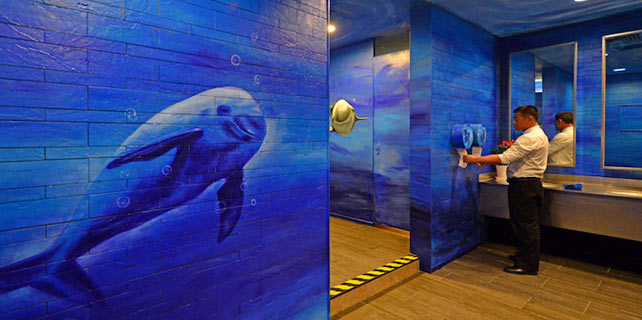'Africa's Miami' boasts Art Deco trove
When Italian architect Giuseppe Pettazzi inaugurated Eritrea's plane-shaped "Fiat Tagliero" service station in 1938, he stunned onlookers by pulling out a gun.
There, the story behind Africa's finest piece of Futurist architecture goes hazy.
In one version, Pettazzi stood defiantly on one of his 18-m concrete "wings" - used as decorative shades for cars entering the garage - and threatened to kill himself should the structure collapse as wooden supports were pulled away.
In another, the excitable architect held the gun to the head of a disbelieving builder, who had hesitated to pull away the struts for fear the long slabs would tumble down.
Either way, the wings stayed up, nobody was shot, and Pettazzi's design skills were vindicated.
Seven decades on, this extraordinary piece of Italian Art Deco, which resembles a plane at takeoff, is still standing in Asmara, the central capital of this former Italian colony.
The "Fiat Tagliero", named for the car firm and the old gas station's owner, is one of 400 buildings that make the remote Eritrean capital one of the world's most fascinating centers for Art Deco.
One of a tiny number of books on the subject - "Africa's Secret Modernist City" by three Asmara-based writers - calls Asmara "the Miami of Africa" in reference to the US city's fame for Art Deco, a design in the Modernism trend known for stylish geometric shapes, bold curves and soft colors.
"The Italians felt they would be here for hundreds of years, so they built and built, and left us this remarkable legacy," said Samson Haile Theophilos, who has written about Eritrean architecture. "But I want to stress the workers, skilled and unskilled, were all Eritrean, so we consider this architecture ours."
Asmara's Art Deco boom came during 1935-41, the last six years of Italian colonial rule of the vast Horn of Africa region then known as Abyssinia.
Italy's 'Urban Utopia'
Unrestrained by European norms, and confident they were laying foundations for the continued expansion of their African colony, Italian architects turned Asmara into an experiment.
A 1937 garage looks like the bottom of a ship with porthole windows. The distinctive "Bar Zilli" imitates a 1930s radio set with windows like tuning knobs.
"Desperate to build quickly, the colonial government ... allowed radical architectural experimentation that would not have found favor in the more conservative European environment," says "Africa's Secret Modernist City".
"Asmara therefore became the world's prime building ground for architectural innovation during the Modern Movement ... a blank canvas on which its Italian colonizers were able to design and build their own urban utopia in east Africa," adds the 2003 publication.
But Fascist leader Benito Mussolini's grand plans for an African empire with Asmara as capital crumbled with World War II.
British forces overran the Italians, who were then allied with Germany's Adolf Hitler, in Eritrea. Asmara's architectural experiment came to an end.
Remarkably, in the intervening decades of near-constant turbulence for Eritrea, the buildings have remained untouched.
'F' for Fascist
While Art Deco is perhaps the most eye-catching, two other "made in Italy" styles make Asmara a true architectural treasure trove: Neo-Classical designs brought by Rome-inspired architects from the 1890s, and the Monumental style that dovetailed with fascist ideas.
"Monumental buildings were meant to dwarf you when you go in and emphasise the power of the occupant," said Samson. "You could almost imagine 'Il Duce' (Mussolini) striding out."
Lying on the main Harnet (Liberation) Avenue, the former Fascist Party headquarters - now Eritrea's education ministry - has a soaring main tower, jagged roofline and imposing entrance.
If an onlooker was in any doubt about the structure's purpose, a twist of the head to the left would reveal that this Monumental building was shaped - on its side - as the letter F.
Not surprisingly, Asmara residents are ambivalent toward their architectural heritage.
On the one hand, they are proud of their forefathers' workmanship. But the buildings also remind the residents of Africa's youngest nation of their colonial subjugation.
"I remember well all this building around 1935 when so many Italians were coming and they were preparing to invade Ethiopia," said 101-year-old Eritrean Zeray Kidanemariam, who worked as a porter for decades.
"But they did it for themselves. We were forced to live in poor areas. To them we were just niggers, nobodies."
Agencies
(China Daily 05/20/2008 page22)














